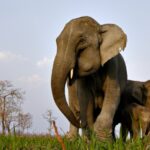
Introduction: Situated in the northeastern state of Assam, Kaziranga National Park is a jewel in India’s crown of wildlife sanctuaries. Spanning approximately 1,030 square kilometers, this UNESCO World Heritage Site is renowned for its incredible biodiversity and is particularly famous for being the last stronghold of the Indian one-horned rhinoceros. The park’s landscape is a captivating blend of wetlands, grasslands, and dense forests, making it a prime destination for nature enthusiasts and conservationists alike.
Flora and Fauna: Kaziranga’s rich biodiversity is a testament to its varied ecosystems:
- One-Horned Rhinoceros: The park is home to more than 2,400 of these magnificent creatures, representing over two-thirds of the world’s population. Their impressive size and solitary nature make them a major attraction.
- Royal Bengal Tiger: Though elusive, the Bengal tiger is a resident of Kaziranga, with an estimated population of around 100 individuals.
- Elephants and Wild Water Buffaloes: Kaziranga boasts one of the highest densities of Asian elephants and wild water buffaloes in the world.
- Birdlife: The park is a birdwatcher’s paradise with over 450 species recorded, including the endangered Great Indian Hornbill and the rare Bengal Florican.
- Flora: The park’s vegetation ranges from tall elephant grass and wetlands to dense tropical forests. Key plant species include the Assam Valley bamboo and various medicinal plants.
Conservation Efforts: Kaziranga is a beacon of successful wildlife conservation in India:
- Anti-Poaching Initiatives: The park has implemented stringent anti-poaching measures, including the deployment of well-trained forest guards and the use of technology for surveillance.
- Habitat Restoration: Efforts to restore and manage natural habitats help maintain the park’s ecological balance and support its diverse species.
- Community Involvement: Local communities are actively engaged in conservation activities, from eco-tourism initiatives to wildlife monitoring programs.
Visitor Tips:
- Best Times to Visit: The ideal time to visit Kaziranga is from November to April, when the weather is pleasant and wildlife sightings are at their peak. The monsoon season, from May to September, can cause flooding and limit park access.
- Safari Options: Visitors can explore the park through jeep safaris and elephant rides. The Central, Western, and Eastern ranges offer different experiences and opportunities to spot wildlife.
- Accommodation: There are various accommodation options ranging from budget lodges to luxury resorts, both within and outside the park. Booking in advance is advisable, especially during peak tourist seasons.
Local Culture: Kaziranga is not only about wildlife but also rich in cultural experiences:
- Tribal Communities: The park’s surrounding areas are home to several indigenous communities, including the Karbi and Mising tribes. Visitors can learn about their traditional lifestyles, crafts, and festivals.
- Cultural Events: Attending local festivals such as Bihu, which celebrates the Assamese New Year, offers a glimpse into the vibrant culture of Assam.
Conclusion: Kaziranga National Park is a sanctuary where the wild and the serene coexist in perfect harmony. Its stunning landscapes, diverse wildlife, and commitment to conservation make it a must-visit destination for anyone interested in exploring the wonders of nature. Whether you are drawn by the majestic rhinos, the lush green scenery, or the rich cultural tapestry, Kaziranga promises an unforgettable adventure into the heart of India’s natural heritage.





Leave a Comment